John Vandaele bericht over de sociale, ecologische, economische en bestuurlijke aspecten van globalisering.
Are we giving enough to save the world's most powerful lung?
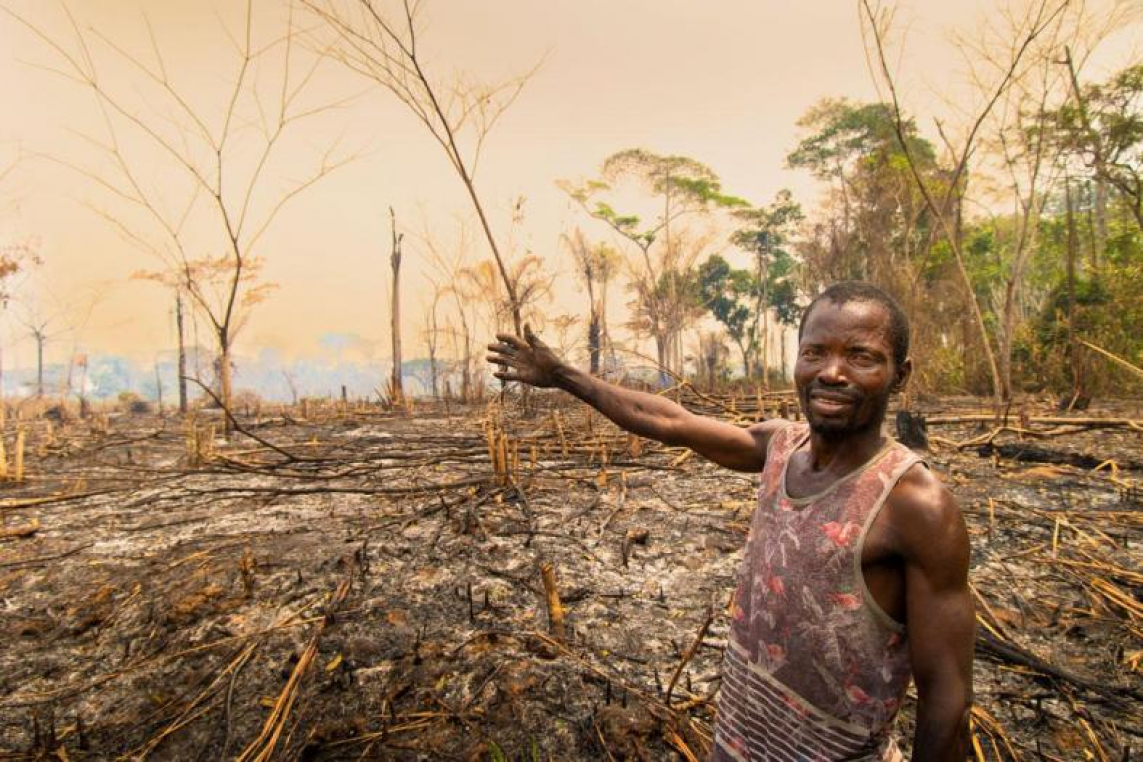
The tropical forests in the Congo Basin, in the heart of Africa, are rapidly disappearing. Several countries, including ours, are investing in sustainable forest management projects. Yet such projects have little chance of success if they do not also help the fast-growing population move forward.
© Bart Lasuy
Although the Amazon forest is significantly larger, the tropical forests in the Congo basin, in the heart of Africa, are today taking more CO2 out of the air. This seems like good news, but these forests are also disappearing at a rapid pace. Several countries, including ours, are investing in projects to protect the forests. Yet such projects have little chance of success if they do not also help the fast-growing population move forward.
Translation of this article is provided by Kompreno, using a combination of machine translation and human correction. More articles from MO* are included in kompreno‘s curation of the finest analysis, opinion & reporting — from all across Europe, translated into your language. Original source.
It is a well-known fact that the Amazon forest is of significant importance for the climate. Much less well known is the fact that tropical forests in Central Africa are nowadays filtering out a greater amount of CO2 from the air than the Amazon forest.
We therefore have every interest in ensuring that the Central African forest is not cut down. However, this remains a difficult balancing act: millions of people depend on it for energy and food, but also for building materials, medicine and income.
As much as 70 per cent of the Central African forest lies in the Democratic Republic of Congo (DRC), which now has about 90 million inhabitants, but will become 200 million by 2050. By the end of this century, that number could double again.
With an annual increase of 3 per cent, the Congolese population has one of the highest growth rates in the world. And it is precisely this rapidly growing population, living off the forest, that is also having a profound impact on it.
Shifting cultivation
What makes the Central African situation special is that deforestation does not stem from large agro-industrial projects or industrial logging, but from the lifestyle of a large part of the population.
Throughout the region, residents use makala, charcoal in the local language, for cooking and heating. This created a veritable charcoal industry in the vicinity of towns. Trees are felled and charred there, after which they disappear into the ubiquitous white bags and are transported to cities.
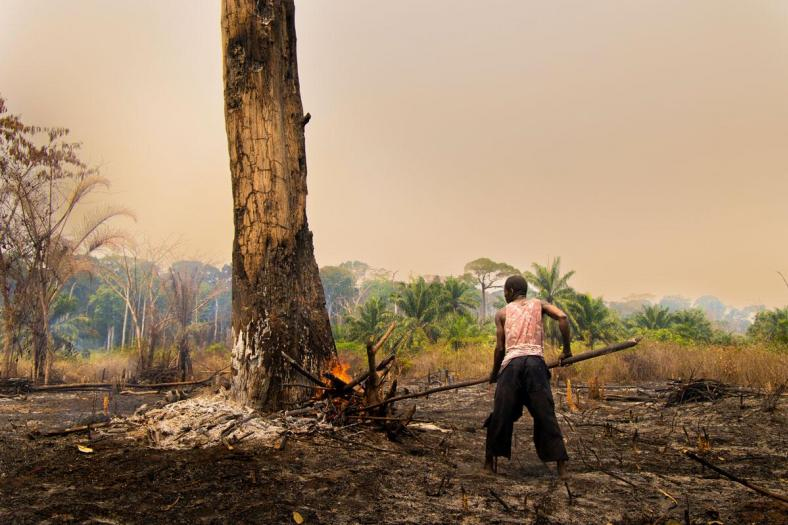
Throughout the Central African region, residents use makala, charcoal in the local language, for cooking and heating. This created a veritable charcoal industry in the vicinity of cities. Trees are felled and charred there, after which they disappear into the ubiquitous white bags and are transported to the cities.
© Bart Lasuy
The inhabitants also depend on the forest for fertile farmland.
The Congolese rainforest is decreasing by at least 1 per cent every year.
Congolese farmers have been practising shifting cultivation for centuries, cutting down a section of forest, letting it dry and then burning it down. That kills the “weeds” and provides manure in the form of ash.
That approach worked well when there were only 5 or 10 million Congolese. Indeed, farmers did not return to the same place until 30 years later, allowing the forest to recover. That’s different nowadays, as shifting cultivation usually amounts to deforestation.
The charcoal industry and shifting cultivation, supplemented by previously modest industrial logging, have the effect of reducing the Congolese rainforest by at least 1 per cent every year. By 2020, according to the World Bank, 1.31 million hectares of intact forest were lost in the DRC, accounting for 854 million tonnes of CO2 emissions. At the current rate, little of the forest would remain at the end of the century.
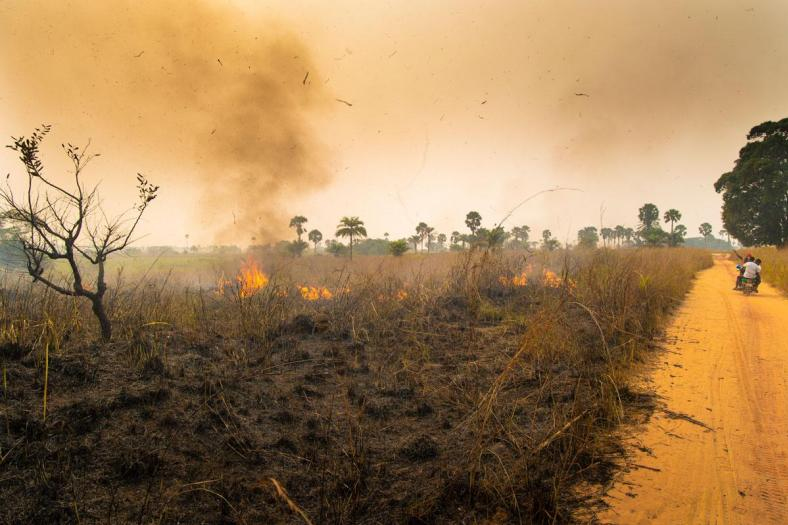
Congolese farmers have been practising shifting cultivation for centuries, cutting down a piece of forest, letting it dry and then burning it down. That approach worked well when there were only 5 or 10 million Congolese. That is different now; nowadays, vagrant farming mostly amounts to deforestation.
© Bart Lasuy
How the Central African rainforest became the world’s main lung
Between 1990 and 2000, tropical rainforests still accounted for 17 per cent of global carbon uptake. With an annual uptake of 530 kilograms of carbon per hectare, the Amazon forest still accounted for more than half of the carbon uptake by tropical forests in that decade.
While African forests absorbed more carbon at 670 kilograms of carbon per hectare per year, because the intact Amazon forests were much larger (8.8 million km2 in 1990 compared to 6 million km2 in Africa), the Amazon absorbed more carbon from the atmosphere overall than Central Africa.
Since then, the situation has changed dramatically. Between 2010 and 2020, carbon capture by the world’s rainforests dropped to 0.68 billion tonnes of carbon or 2.5 gigatonnes of CO2. (For the record, each kilogram of carbon absorbed into the atmosphere translates into 3.67 kilogrammes of CO2.) That still accounted for only 7 per cent of global CO2 emissions, which have since risen to 35 billion tonnes.
The reason is that Amazonian forests absorbed much less carbon: down from 530 kg per hectare in the 1990s to 230 kg between 2010 and 2020. By contrast, carbon uptake in Central Africa barely dropped: from 670 to 630 kilograms per hectare.
That the African intact rainforest declined slightly faster than the Amazon forest (a 28 per cent decline compared to 20 per cent) did not prevent African rainforests from already accounting for more than half of the carbon uptake by tropical forests over the past decade.
‘Carbon storage in African forests remained almost stable since 1985, although there was a slight decrease after 2010,’ says Wannes Hubau, researcher at Ghent University and the Africa Museum. ‘More trees are dying in the Amazon because it is warmer and drier.’
‘The Amazon region also has a faster ecosystem, so the greater tree growth that resulted from rising carbon levels in the air also translated into more mortality faster. In the Amazon, a carbon atom remains bound in trees for 56 years on average, in Africa it is 69 years.’
By measuring how much carbon both forests absorbed from the air in recent decades, Hubau and fellow scientists found that the rainforest in Central Africa has now become more important than the Amazon forest as a collector of CO2.
The researchers predict that the Amazon will completely lose its ability to absorb carbon in the next 15 years, and may even become a source of carbon by 2035. It is up to Africa to take over the important role. By 2035, the African rainforest will account for almost all of the one 1 billion tonnes of CO2 captured by the rainforests.
Hubau: ‘The trees themselves, i.e. above ground, account for 62 billion tonnes of carbon. But there is also the subsoil. In the dry soil, storage remains limited, with 13 billion tonnes of carbon stored in 300 million hectares. But the Central African rainforest also has 16.7 million hectares of swampy peat forests. These have stored as much as 29 billion tonnes of carbon in the wetland over centuries.’
All together, dry and swamp forests, topsoil and subsoil, the Central African forest basin holds 104 billion tonnes of carbon. When that is released and starts binding with oxygen, 382 gigatonnes of CO2 is added.
Hubau: ‘That is more than 10 times the current annual emissions of the whole world or 12 per cent of the total amount of carbon that is in the atmosphere as CO2.’ So cutting down the rainforest not only means that an important CO2 absorber would disappear, but also that this huge carbon storage would be lost.
Foreign backers
To protect the forest and encourage reforestation, money and resources are needed. One of the main donors is the Central African Forest Initiative (CAFI). Apart from Norway, the main donor and initiator, the EU, France, Germany, South Korea and Sweden are also investors.
If you add up the public funds over the past five years, you don’t get that far above $1 per Congolese.
Belgium is also making its contribution: International Cooperation Minister Meryame Kitir recently decided to invest 3 million euros in CAFI.
Together with the Congolese government, CAFI signed an initial letter of intent back in 2015. In it, the donors, with Norway in the lead, pledged to release $200 million between 2016-2020 for programmes to ‘stop the loss of natural forests in DRC by 2030.’
Gradually, other commitments were added, amounting to $249 million. So that works out to $50 million a year — just over half a dollar per Congolese per year.
According to their Congo expert Pierre Guigon, the World Bank invested some $130 million since 2010 to fight deforestation and test new, more sustainable livelihoods — some $10 million a year, in other words.
Apart from this, there are also funds to manage national parks and protected areas. Benjamin Belanjeelwa is in charge of international funding at the Institut Congolais pour la Conservation de la Nature (ICCN). He tells us that the ICCN has $42 million a year to manage the parks, some of which are larger than Belgium.
Of that amount, 98 per cent comes from abroad, Belanjeelwa tells us. The EU and Germany are the main donors in this regard. So if you add up those various public sources of funding over the past five years, you don’t get that far above $1 per Congolese.
Private money funds
Apart from public money funds, more private money also flows to Congo to preserve the forest or engage in reforestation.
In Belgium, for example, this involves Colruyt, which has invested some 10 million euros in recent years and plans to invest some 65 million euros in a reforestation project over the next 25 years. But also Faja Lobi, the NGO of Ghent-born Jurgen Heytens, which has used its own savings and all kinds of small and bigger donations to invest some 2 million euros in reforestation over the past 10 years.
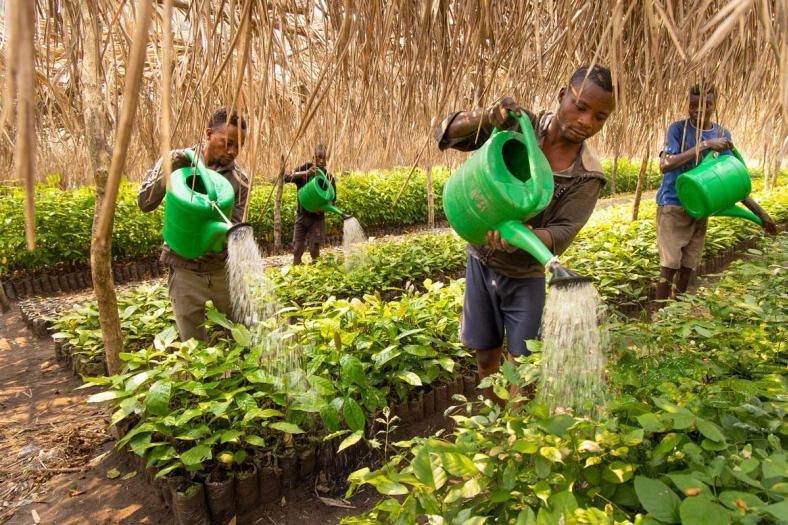
Reforestation project Faja Lobi
© Bart Lasuy
Companies and organisations that want to work in a more climate-friendly way can offset their own emissions by buying carbon credits on the so-called voluntary carbon market. Carbon credits are realised through projects that reduce emissions or absorb CO2: i.e. it can be the spreading of improved furnaces, the realisation of renewable energy or reforestation initiatives.
Such sustainable projects must meet certain standards. For example, the carbon emission savings achieved must be incidental or have a certain permanence. Specialised organisations examine whether these conditions were met and how many tonnes of carbon — how many carbon credits — were saved or stored.
How much money is involved in the DRC is hard to say. People with their nose to the grindstone indicate that private money sources are not exactly soaring yet.
A World Bank adviser tells us that projects like those of Colruyt and Faja Lobi are rather rare in Congo. And on the register of Verra, a major label for carbon credits, we count only nine projects for the DRC, including projects for improved carbon furnaces and projects that protect existing forests.
On the register of Gold Standard, another key sustainability label for carbon credits, we count 14 initiatives certified in the DRC. Thirteen of these revolve around the spread of improved charcoal kilns.
The only reforestation project is ECOmakala, a WWF initiative to stop deforestation in Virunga Park, in eastern Congo. The project managed to convince farmers to plant pieces of land they do not use anyway, mostly because they are too steep, with fast-growing eucalyptus trees.
From the eucalyptus trees, they end up making makala (charcoal). In addition, ECOmakala not only sells improved ovens, but also manufactures them itself in Goma.
Africa’s water tower
If you add up all the public money funds, you arrive at about €100 million a year. While the private money funds are less easy to map accurately, they are certainly smaller than the public money funds, as Herman Noppen and Antoine Geerinckx of CO2-logic — part of Southpole, the world’s largest provider of climate solutions and projects, including in the DRC — testify.
Add up the public and smaller private money funds, and you can conclude that less than $200 million a year went to the DRC over the past five years to establish a development path that protects the forest while increasing the chances of prosperity for its fast-growing population.
By 2031, DRC must stop the loss of its forests, preferably even reverse it.
Today, the DRC has a population of about 90 million. In other words, less than two dollars of foreign funds per Congolese is spent on this gigantic task.
Is that enough to convince one of the world’s poorest and fastest-growing populations not to do what most other nations have already done: cut down their natural forests? Last year, the Congolese government submitted a National Determined Contribution as its contribution to the Paris climate agreement, which should cost $48 billion — that is, four times the total current government budget. An immense and not very realistic amount, but it does indicate the size of the gap with what is currently being spent.
Make no mistake, the Congo basin is Africa’s water tower. Should this green sponge be lost forever, the consequences would be incalculable.
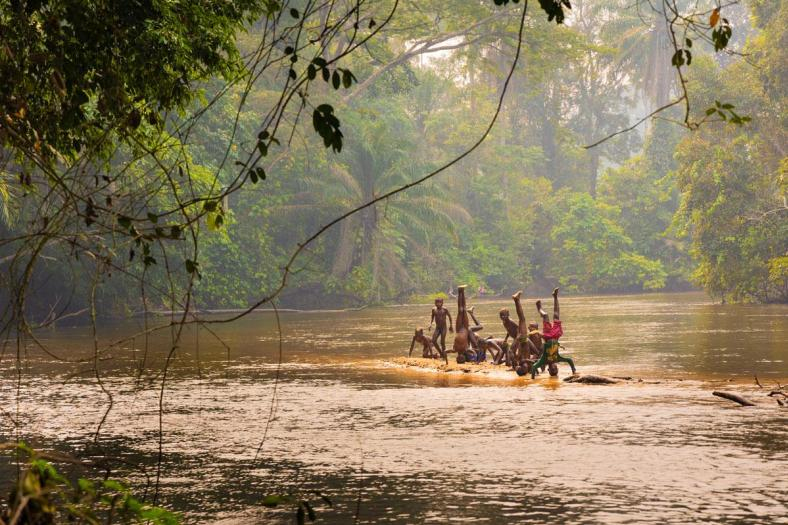
© Bart Lasuy
Not only African but also global climate regulation would be thrown into serious disarray. Ten times the current global CO2 emissions would be released (see box) and a powerful collector of CO2 would disappear irrevocably.
‘The disappearance of all tropical rainforests would lead to a doubling of the current observed warming since 1850. In addition to that warming, complete deforestation would also lead to extreme shifts in rainfall,’ adds Marijn Bauwen of Ghent University.
The realisation that something must be done has finally sunk in. More funding seems to be on the way. As part of the Global Forest Finance Pledge, at the 2021 Glasgow Climate Summit, the EU pledged to invest €250 million in the Congo Basin, especially in Cameroon, Burundi, the Republic of Congo and the DRC. A year later, these plans are still not quite concrete.
At the same climate summit, CAFI and the DRC also signed a second agreement for the period 2021-2031. Half a billion dollars has been pledged for the period 2021-2026. In return, the DRC must stop, and preferably reverse, the loss of its forests by 2031.
DRC’s annual forest loss was estimated at 6678 km2 for the period 2014-2018 — more than a fifth of Belgium’s territory. That needs to be reduced to zero by 2031.
A big challenge, because projects to protect the forests have little chance of succeeding if the poverty-stricken Congolese population does not (considerably) benefit from them. The task at hand, therefore, is to assist the Congolese population to establish an ecological development path that increases their prosperity, while convincing them to leave the rainforest largely intact.
 This reportage was produced with the support of the Pascal Decroos Fund for Special Journalism.
This reportage was produced with the support of the Pascal Decroos Fund for Special Journalism.
Maak MO* mee mogelijk.
Word proMO* net als 2798 andere lezers en maak MO* mee mogelijk. Zo blijven al onze verhalen gratis online beschikbaar voor iédereen.
Meer verhalen
-
Report
-
Report
-
Report
-
Interview
-
Analysis
-
Report










 Oxfam België
Oxfam België Handicap International
Handicap International